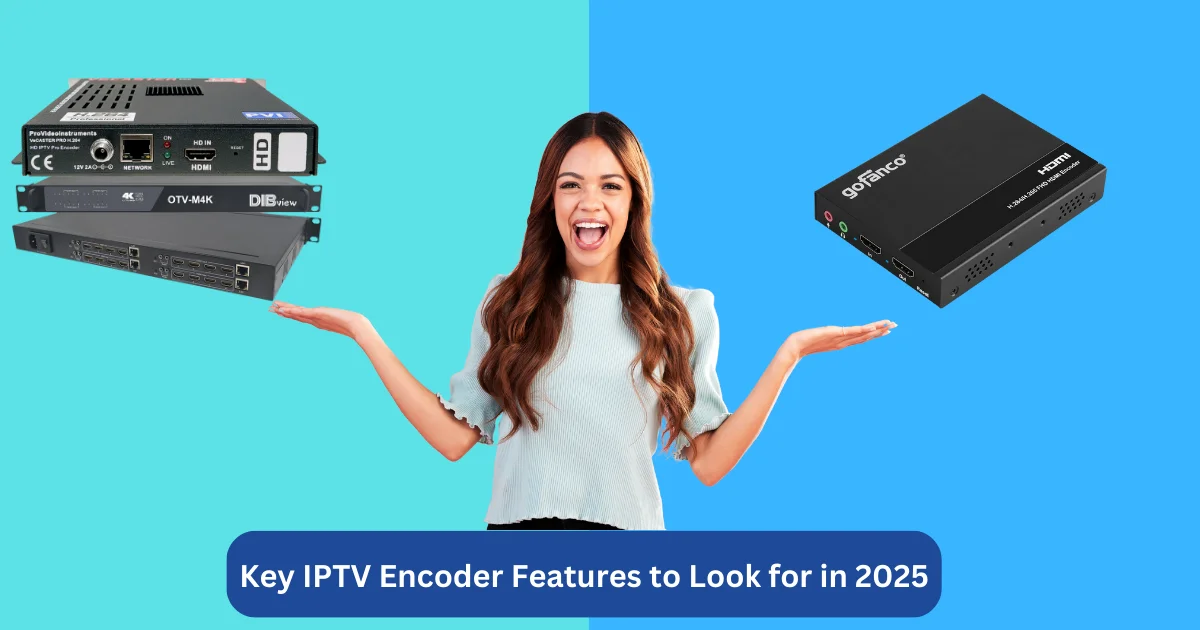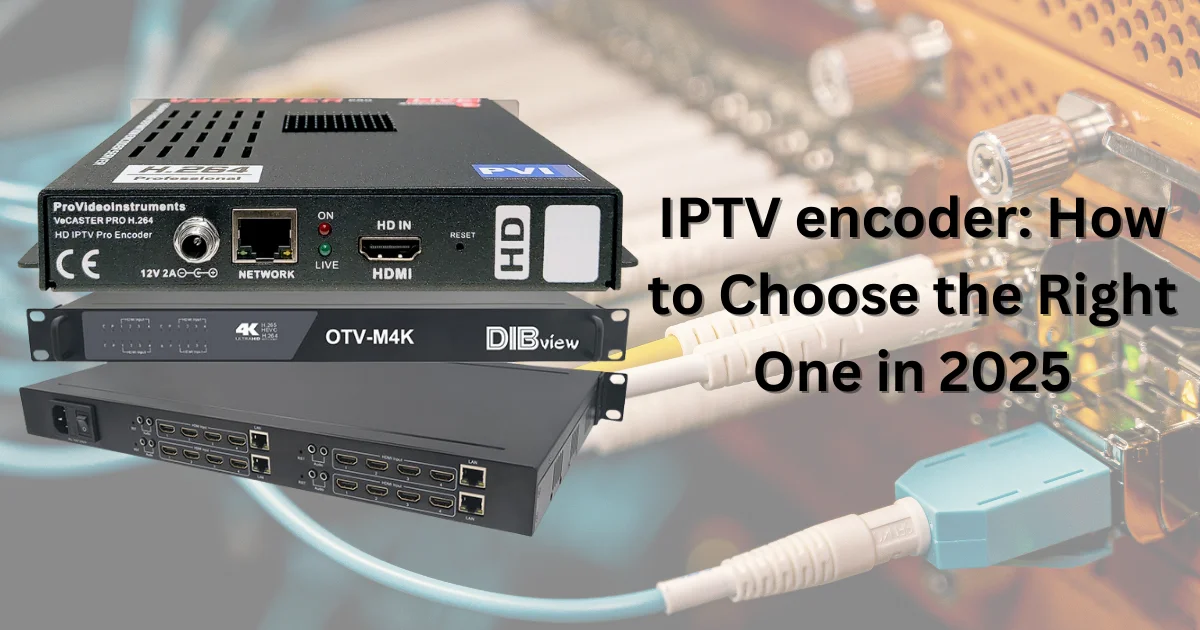How to Choose the Right IPTV Encoder in 2025: A Comprehensive Guide
As we move further into the digital age, streaming content is more important than ever. Whether you’re an individual looking to stream your favorite shows, or a business aiming to broadcast live events, selecting the right IPTV encoder is crucial. The IPTV encoder serves as the backbone of any streaming operation, converting video content into a digital stream that can be broadcasted over the internet. But with so many options available, how do you choose the best IPTV encoder for your needs in 2025?
In this guide, we will walk you through the key factors to consider when selecting an IPTV encoder, the features you should look for, and the best options available in 2025. By the end of this article, you’ll have a clear understanding of how to make an informed decision that will ensure smooth, high-quality streaming for your audience.
What is an IPTV Encoder?
An IPTV encoder is a device or software that converts video content into a digital stream. It compresses video files, which are then transmitted via the internet to streaming platforms or content delivery networks (CDNs). Without an IPTV encoder, it would be impossible to stream video content online in a way that ensures high quality and reliability.
When you decide to stream live events, sports broadcasts, or video on demand (VOD), the IPTV encoder plays a key role in ensuring that the video is properly encoded and delivered in the best possible quality. It’s responsible for video compression, managing bitrate, resolution, and ensuring that your stream doesn’t suffer from excessive buffering or lag.
In 2025, choosing the right IPTV encoder means considering your specific needs, such as video resolution (e.g., 4K, 1080p), bitrate requirements, and encoding speed. An efficient IPTV encoder can help you deliver high-quality video streams to your audience while also optimizing bandwidth and reducing latency.
Why Choosing the Right IPTV Encoder Matters in 2025
In 2025, the demand for high-quality streaming is higher than ever before. Whether you’re live-streaming sports events, corporate meetings, or entertainment content, the quality of your stream heavily depends on your IPTV encoder. Here’s why choosing the right one is crucial:
1. Impact on Streaming Quality
The quality of your stream is the first thing your viewers will notice. A poor quality stream can result in choppy video, poor audio synchronization, and constant buffering. A high-quality IPTV encoder ensures that your stream is clear, smooth, and delivers a great user experience.
2. Cost-Efficiency
Streaming can be expensive, especially if you’re handling high-volume streams or 4K content. Choosing an encoder that allows you to balance video quality with bandwidth consumption can save you money. Additionally, by choosing the right encoder, you avoid investing in unnecessary equipment or software.
3. Compatibility and Flexibility
Your IPTV encoder must be compatible with the platforms you plan to stream on, such as YouTube, Facebook Live, or your private CDN. Choosing an encoder that supports a variety of streaming protocols (like RTMP, HLS, and RTSP) ensures that you won’t be locked into a specific platform or service.
Factors to Consider When Choosing an IPTV Encoder
When selecting an IPTV encoder in 2025, there are several factors you need to consider to ensure you get the right solution for your needs. These factors influence the overall quality, performance, and cost of your stream. Let’s break down the most important ones:
1. Resolution and Video Quality
One of the most important considerations is the resolution your IPTV encoder supports. As streaming moves to higher-quality formats like 4K, you need to ensure that your encoder can handle high-resolution video without compromising on performance.
Key Considerations:
- Does the encoder support 4K or 1080p resolution?
- Does it support HDR (High Dynamic Range) for enhanced video quality?
- How does the encoder handle video compression without degrading quality?
2. Compression Standards and Bitrate
Video encoding relies heavily on compression techniques to reduce file sizes without sacrificing video quality. The most commonly used compression standards are H.264, H.265 (HEVC), and AV1. Each of these standards has its strengths and weaknesses.
Key Considerations:
- What compression standards are supported?
- Can you adjust the bitrate to balance video quality and bandwidth usage?
- Does the encoder handle adaptive bitrate streaming (ABR) for varying network conditions?
3. Latency and Delay
Low latency is especially important for live streaming. Whether you’re streaming sports events, gaming content, or webinars, a delay of even a few seconds can negatively impact the viewing experience. Choose an IPTV encoder that minimizes latency and allows for real-time streaming.
Key Considerations:
- How low is the encoder’s latency?
- Does the encoder support low-latency streaming protocols like WebRTC?
4. Encoding Speed and Performance
Real-time encoding is essential for live streaming. The speed and performance of the encoder directly affect the time it takes to process video and push it out to the stream. If you’re planning to stream multiple video feeds or have high demands for video quality, this is an essential factor.
Key Considerations:
- Does the encoder offer hardware-based encoding for faster processing?
- Is the encoder capable of handling multiple streams simultaneously?
5. Price
The price of IPTV encoders can vary significantly based on features, performance, and brand. It’s important to balance your budget with your streaming needs. Higher-end encoders may offer advanced features but can come with a higher price tag.
Key Considerations:
- What is your budget for encoding equipment or software?
- Does the encoder offer good value for the features it provides?
6. User Interface and Ease of Use
A user-friendly interface can save you a lot of time and frustration when setting up your stream. Look for encoders that have an intuitive interface and offer easy configuration options.
Key Considerations:
- Is the encoder’s interface easy to navigate?
- Does the encoder offer easy-to-use presets for quick setup?

Key IPTV Encoder Features to Look for in 2025
As you research different IPTV encoders, certain features can help set one encoder apart from another. These features can make the difference between a smooth, professional stream and a frustrating experience for both you and your audience.
1. Multiple Streaming Protocols
Look for encoders that support a range of streaming protocols, such as RTMP, HLS, and RTSP. This allows you to stream to a variety of platforms and devices without any issues.
2. Advanced Video Processing Features
Some encoders come with advanced features like frame interpolation (to reduce motion blur), noise reduction, and deinterlacing. These features improve the quality of your video and can make your stream look more polished.
3. Cloud-Based vs. On-Premises
Cloud-based encoders are more flexible and cost-effective, especially if you don’t want to deal with maintaining hardware. On-premises encoders, on the other hand, can offer more power and control if you have the necessary infrastructure.
4. Integration with CDNs
Integration with content delivery networks (CDNs) ensures that your content can be distributed globally with minimal delay or buffering. Make sure your encoder supports easy integration with popular CDNs.
5. Scalability
If you anticipate growing your streaming operation, choose an encoder that can scale with your needs. This is particularly important for businesses that need to handle increased traffic or expand to multiple platforms.
IPTV Encoder vs. Traditional Broadcast Encoders
While traditional broadcast encoders have been the industry standard for many years, IPTV encoders are quickly becoming the preferred choice for content delivery over the internet. Here are some key differences between the two:
1. Cost and Flexibility
IPTV encoders are generally more cost-effective than traditional broadcast encoders. Additionally, they offer more flexibility, as they can be used for a variety of platforms and devices, whereas broadcast encoders are often tied to specific broadcast channels.
2. Compatibility
IPTV encoders are designed to work with the latest streaming protocols, which makes them more compatible with internet-based platforms. Traditional broadcast encoders, on the other hand, are designed for linear TV broadcasts.
3. Scalability
IPTV encoders are scalable, meaning you can easily upgrade your system to accommodate more streams or higher-quality content. Traditional broadcast systems are often more rigid and harder to scale.
Step-by-Step Guide to Selecting the Best IPTV Encoder for Your Needs
1. Assess Your Streaming Needs
- Are you streaming live events, VOD, or both?
- What resolution do you need (e.g., 720p, 1080p, or 4K)?
- Do you need to stream to a single platform or multiple platforms?
2. Consider Your Budget
- What are you willing to spend on an encoder?
- Will you opt for a hardware-based or software-based solution?
3. Check Technical Requirements
- Does your current infrastructure support the encoder you want to purchase?
- Is the encoder compatible with your streaming platforms?
4. Evaluate Scalability and Long-Term Needs
- Will your encoder support future growth?
- Can it handle more streams or higher-quality content as your needs evolve?
5. Test User Experience
- Can you easily navigate the encoder’s interface?
- Does it offer presets for easy setup?
Conclusion: Make an Informed Choice for Seamless Streaming
Choosing the right IPTV encoder in 2025 is a critical decision that can impact the quality of your streaming experience. By considering factors such as video resolution, bitrate, latency, and budget, you can find an encoder that meets your specific needs. Make sure to evaluate key features like multiple streaming protocols, video processing, and scalability to ensure your encoder can support both your current and future streaming requirements.
Now that you have a better understanding of what to look for in an IPTV encoder, take the next step and choose the one that best aligns with your needs. Whether you’re an individual streamer or a business, selecting the right IPTV encoder will ensure that you deliver high-quality streams with minimal hassle.
Ready to stream with confidence? Start by selecting the perfect IPTV encoder for your next live event or content delivery.
